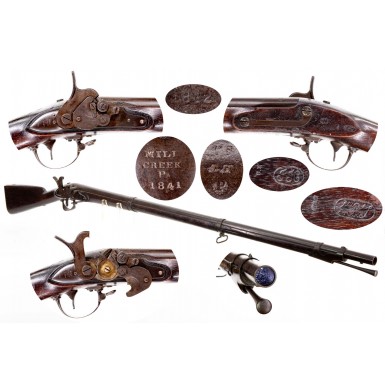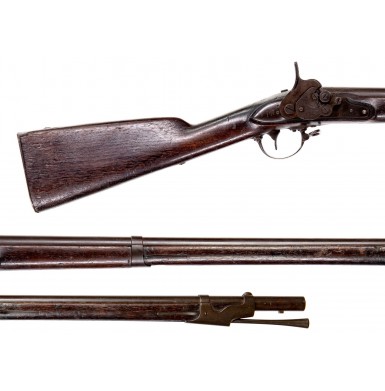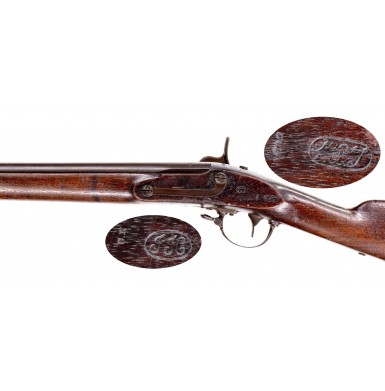Crisp & Untouched US Model 1840 Nippes-Maynard Altered Musket
- Product Code: FLA-3725-SOLD
- Availability: Out Of Stock
-
$1.00
With the adoption of the US Model 1842 Musket, the US military officially embraced the percussion ignition system as standard for all small arms and as the ignition system to be used for the foreseeable future. While the percussion system had been introduced experimentally with Hall Patent Carbines circa 1833, it was the adoption of the US Model 1841 “Mississippi” Rifle circa 1841 and then the US Model 1842 musket, that cemented the system as the current standard. Almost immediately, the Ordnance Department began to consider the method best suited to alter the huge stocks of flintlock muskets in inventory to the new percussion system. Hundreds of thousands of older US Model 1816/22/28 pattern muskets were currently in stores around the country, and even worse, many of the newly made US Model 1835/40 flintlock muskets were still being delivered by contractors, even as the recently adopted Model 1842 percussion muskets were being produced at the national armories at Springfield and Harpers Ferry.
In 1842, a group of Ordnance Department inspectors began the laborious task of inspecting and classifying the nearly one million flintlock rifles and muskets in storage around the country for the purposes of determining which were suitable for alteration to percussion and in what order the alterations should be accomplished. In 1844, an Ordnance Department board of officers was convened to consider the best method by which the percussion alterations should be performed, and it was at this time that the “Belgian” or “Cone in Barrel” alteration system was officially adopted. By early 1848, the necessary machinery had been produced, and the percussion alteration operations were underway at the national arsenals at Springfield and Harpers Ferry, as well as at four regional arsenals: Watertown, Allegheny, Watervliet and Washington.
Nearly simultaneously, with the constant pressure to “build a better mouse trap”, another Ordnance Department board was convened in February of 1845 to consider a newly invented automatic priming system. The system had been invented by dental surgeon and firearms innovator Dr. Edward Maynard. His Maynard Tape Priming System was an automated priming mechanism that utilized a varnished strip of paper with small amounts of fulminate of mercury sandwiched between the two layers, similar to a modern-day child’s cap gun. The system advanced the roll of primers each time the hammer was cocked, and upon firing, a sharp lip on the lower edge of the hammer’s nose cut off the spent cap. Despite the fact that the Ordnance Board felt that Dr. Maynard’s design was experimental at best, in March of 1845 they paid him a $4,000 royalty for the right to adapt up to four thousand small arms to his system which was protected under US Patent #4,208; issued in 1845. These experimental weapons would include 200 Sharps Model 1851 carbines and 2,000 US Model 1840 flintlock muskets. Interestingly, the US Navy agreed to try out the system as well, paying Maynard an additional $1,000 to use his system on 1,000 US Jenks Naval Carbines that would be manufactured by Remington. The mostly positive results of the experimentation with the system result in further trials, with the US government paying Maynard an additional $50,000 in 1854 and applying an improved version of his automatic priming lock to the alteration of some 20,000 flintlock muskets. These Remington-Maynard altered muskets performed well enough that the US government would subsequently pay Maynard an additional $75,000 for the use of his priming system on the US Model 1855 series of arms. However, this pathway to the adoption of the Maynard automatic priming system for universal issue by the US Ordnance Department began with the alteration of 2,000 US Model 1840 flintlock muskets by Daniel Nippes during 1848-1849.
The selection of Daniel Nippes of Mill Creek, PA to perform this work was appropriate for several reasons. First, Nippes was a long-time US Ordnance Department contractor, having been involved in the production of arms on contract for the previous decade and having previously been employed by ordnance contractor Marine T. Wickham, who was himself was a former Ordnance Department small arms inspector. Nippes’ father had also been an Ordnance Department contractor back to the US M1808 musket contracts, so he was a second-generation arms maker, involved in the family business. Additionally, Nippes’ small initial contract for 4,000 US M1840 Flintlock Muskets had not been issued until late in 1840 and deliveries had not begun until 1843. He had received an additional contract in 1846 for another 1,600 guns, and some 600 of these guns had yet to be delivered when he was approached to handle the alteration of 2,000 US M1840 muskets to percussion via the Maynard Tape Priming system. As a result, of the 5,600 US M1840 muskets that Nippes had been contracted to produce, only 5,100 would be delivered in flint, and as many as 500 of the 2,000 altered muskets would be provided from previously undelivered muskets. In fact, some of these muskets were never completed in flint, and were actually produced as automatic tape priming muskets, meaning that at least some were not actually “alterations”.
The alteration from flintlock to percussion was relatively simple, with minimal changes made to the actual musket. The guns retained their original 42”, round, .69 caliber smoothbore barrels, secured by three flat iron bands that were retained by band springs. Unlike the later alterations to the Maynard Tape Primer performed by Frankford Arsenal with Remington locks, the Nippes alterations did not use a patent breech. Instead, a long round bolster was threaded into the original flintlock touch hole, with a spanner style percussion cone positioned to receive the primer tape. The external flintlock battery was removed from the lock and some of the original screw holes were used to install the tape primer magazine, while others were filled. The primer magazine had a door that pivoted downward to open, rather than a hinged door like those used on later US arsenal produced Maynard primed arms. The uniquely shaped flat sided hammer had a small projecting edge on the lower face to cut the primer tape after it was used. Mating marks, usually consisting of an alphanumeric such as J 7 were used to mate the parts of the musket during the alteration process, with the marks being found in the lock mortise, on the side of the barrel in front or behind the drum bolster and sometimes on the hammer. Although the M1840 was technically an “interchangeable parts” musket, it was still felt necessary to mate original barrels and stocks for the best fit and finish. Nippes initially received a contract to alter 1,000 US M1840 muskets on February 9, 1848, and these guns were delivered in three lots beginning with 300 in November of 1848 and with two lots of 400 and 300 respectively, delivered in January and February of 1849. A second contract for 1,000 guns was issued on November 18, 1848, and these guns were delivered in lots of 500 in June and August of 1849. It appears that the initially delivery of 300 guns on November 4, 1848 were probably unfinished, yet to be delivered US M1840s and it would be some of these guns that would have been produced as percussion arms and never have had flintlock batteries on their locks. The majority of the other 1,700 guns appear to have been sent to Nippes from storage at the Frankford Arsenal in Philadelphia. Nearly all of these US M1840 muskets were guns that Nippes had originally produced, although a few Pomeroy produced muskets were included in the shipments as well. In nearly all cases, these Pomeroy guns received Nippes marked altered locks, and only the inspection marks reveal that the stock or barrel originated on a Pomeroy contract gun.
Offered here is a FINE attic condition example of a scarce US Model 1840 Nippes-Maynard Altered Musket. The gun is 100% complete, correct and original. The musket retains clear markings throughout, with the exception of the patent marks on the primer door, and the tape priming system remains complete and fully functional. The lock retains its original markings to the rear of the hammer, which read in four vertical lines: MILL / CREEK / PA / 1841. The door of the tape primer magazine reads in three horizontal lines: EDWARD MAYNARD / PATENTEE / 1845, but this mark is weak and not fully legible. The breech plug tang is dated 1842, and the breech is marked in three lines: US / JH / P, with the “P” proof in a depressed sunburst. The “JH” mark is that of civilian arsenal sub-inspector Joseph Hannis, who inspected a wide variety of contract arms and components from the late 1830s through the end of the Civil War era, making him one of the most prolific of arms inspectors during the period. Hannis also served as the sub-inspector for many of M1840 muskets delivered by Nippes under his various contract, with Captain William Anderson Thornton often serving as the approving inspector. As the counterpane of the musket is clearly stamped with Hannis’ script JH cartouche in the sub-inspector position and with William Anderson Thornton’s script WAT in the final inspection position. Due to the early 1841 lock and 1842 barrel dates, we know that the gun was originally one of the Nippes contract M1840 muskets delivered in flint that was subsequently altered to the Maynard system by Nippes. More than likely this gun was early enough to have been returned to Nippes for the alteration, rather than still being one of the guns on hand at the factory. Further, disassembly reveals that the lock was altered from flint to the Maynard system. The counterpane also includes very tiny block SK forward of the JH cartouche and with a tiny script WAT in front of the larger script WAT cartouche. These two reinspection marks were applied after the alteration to the Maynard system, thus accepting the modified musket for service. The “SK” mark is that of civilian sub-inspector Samuel Knous, who was sent to Nippes’ Mill Creek manufactory to inspect altered muskets in November of 1848. The alphanumeric reassembly mating mark on this gun is J 8. The mark is present in the lock mortise but the mating mark on the barrel in front of or behind the bolster has been eroded by the flash of the fulminate of mercury.
As previously noted, the musket remains in about FINE attic condition and is 100% complete, correct and authentic in every way. The metal has a thickly oxidized, rich brown patina with some very light and evenly distributed minor roughness and flecks of pinpricking over most the barrel as well as the buttplate. The bands, triggerguard and lock have an equally rich and heavily oxidized brown patina. When the bands are moved, the barrel is bright and shiny underneath, as would be expected. As noted, the barrel shows some very lightly scattered pinpricking over most of its length, but also shows some light to moderate pitting around the breech and bolster area. As noted, the lock remains mechanically EXCELLENT and functions perfectly on all positions with the Maynard mechanism remaining fully functional as well. Internally the tumbler, bridle and sear all retain most of their bright fire blued finish. Even the original spanner wrench cone (nipple) remains in the drum bolster and is still in crisp condition, although it does show use and is currently plugged with debris. The bore of the musket remains in about GOOD condition. The bore has the same thickly oxidized dark brown patina as found on the exterior of the barrel and shows evenly distributed light to moderate pitting along its length. The original trumpet head ramrod remains in the channel under the barrel. The rod is full-length complete with fine threads at the end. Both original sling swivels remain in place as well, the lower mounted on the front bow of the triggerguard and the upper on the middle barrel band. The original brass blade front sight is in place on the front strap of the upper barrel band. The stock remains in about VERY FINE overall condition. It is solid, full-length and free of any breaks or repairs. The stock retains crisp edges and lines and as noted has two very crisp cartouches as well as a small additional inspection mark on the counterpane opposite the lock. The stock does show numerous small bumps, dings and handling marks, but is free of any major damage or indications of abuse. There is a small finish chip of wood missing in front of the trigger plate and a couple of tiny splinters missing from the ramrod channel, but the stock remains very crisp with some of the original feathery texture as well.
Overall this is an extremely nice, essentially untouched example of a very scarce US M1840 Nippes-Maynard Alteration Musket. With only 2,000 produced, these are inherently very scarce guns, but their survival rate appears to be particularly low. We know that 200 of the guns were re-altered to conventional percussion muskets by P. Bouron of New Orleans for the Confederacy during the early part of the war, leaving only 1,800 to have potentially survived in this state. As some were later reconverted to flint by collectors during the 1950s and 1960s, before the importance of the alteration was understood, few appear to have managed to make their way into modern day collections in the Maynard altered state. From a historical standpoint this is a very important musket as it was the first of the automatic priming percussion muskets to be tested by the US military and was the direct forerunner to the Remington-Maynard alterations and the US M1855 family of arms. In all reality, an advanced collection of US M1855s needs one of these guns as the first of that line. Rarely do these guns come to market, and even less often in this wonderful state of preservation. This is a great example of a rare gun in wonderful condition that will be a fantastic addition to your collection.
SOLD
Tags: Crisp, Untouched, US, Model, 1840, Nippes-Maynard, Altered, Musket














